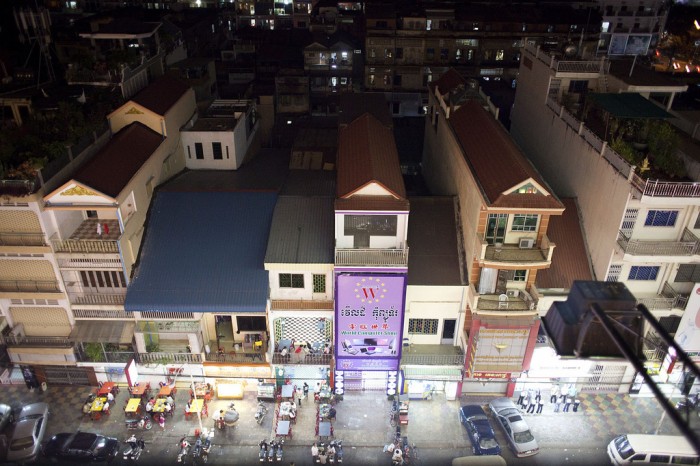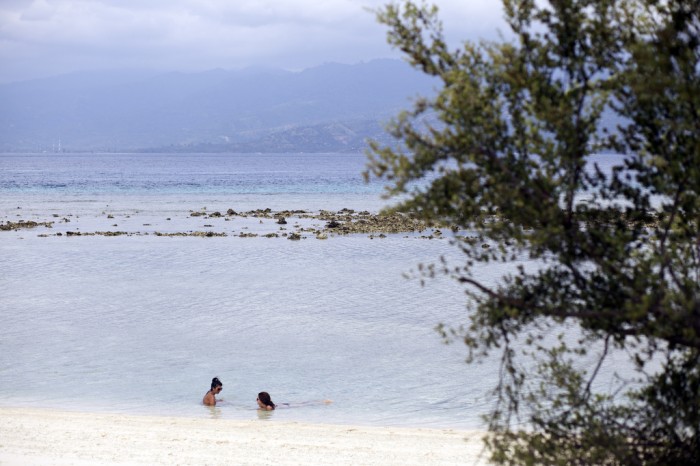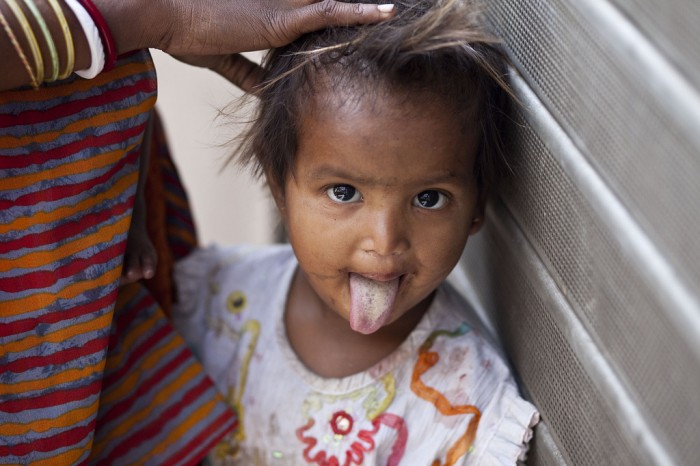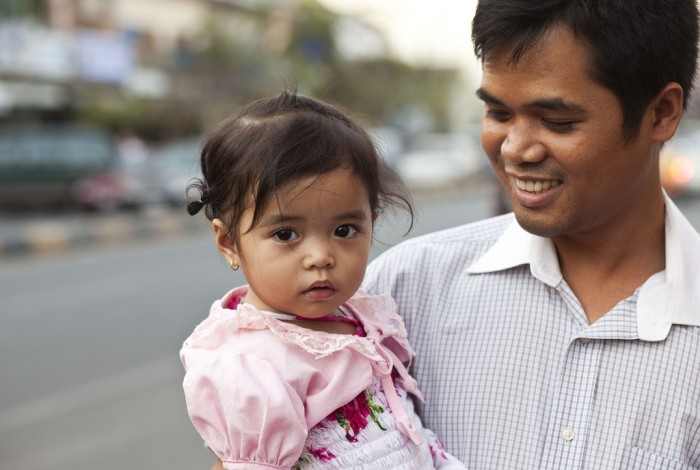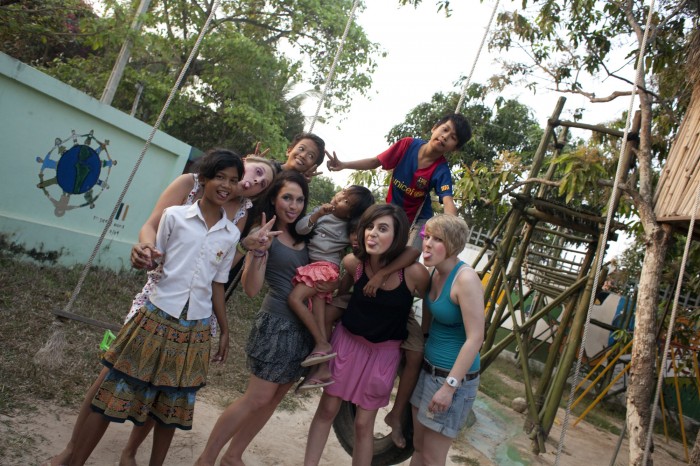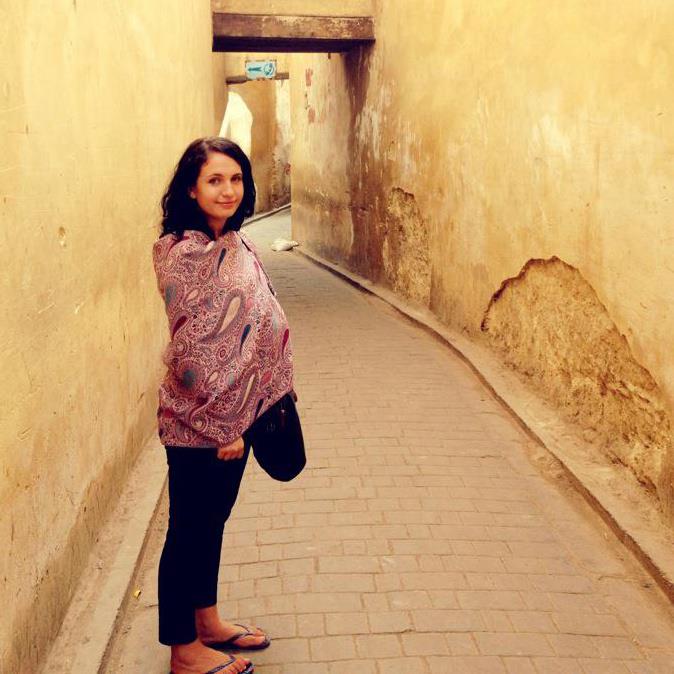Phnom Penh – City Guide
I’ve been to Cambodia three times and know that I’ll be there many more. Phnom Penh is the city I never mean to get caught up in, but always do. For me it has the perfect mix of history, great local and western food, friendly people and rawness that you struggle to find in the developed world. I have read contrasting reports on safety in Phnom Penh, but there has never been a moment when I felt unsafe.
Costs in Phnom Penh
Accommodation is a bargain in Phnom Penh, even by South East Asia prices. Expect to pay $4.50 for a bed in a dorm room or $6 for a private room in a hostel. It’s possible to get a cheap room in a guesthouse for $5 and up. Rooms at the lower end of the scale will likely be without hot water. For $10 a night you can enjoy a little more comfort, with aircon, ensuite with hot water and maybe even a tv.
Food is very affordable in Phnom Penh and it’s often cheaper to eat out than to try to prepare your own food. Street food will set you back $1-2 and you can find decent restaurants meals for around $5. If you stretch your budget to $10 you can find yourself eating very well.
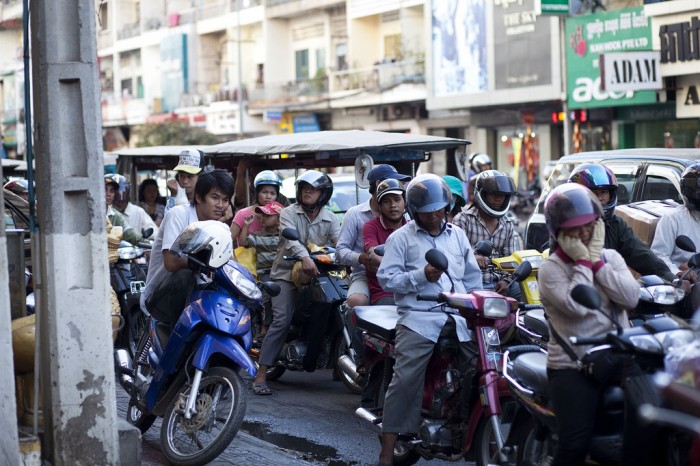 Transport is very cheap here too, so it makes Phnom Penh an easy city to get around. Expect to pay $1 for a trip throughout the city on a motorbike. If you’re in a group, it’s better to take a tuk-tuk. Single tuk-tuk journeys run at about $1-2. Consider that hiring a tuk tuk and driver for the day can be as inexpensive as $10, so if you’re planning to explore the city extensively this is the best option. Phnom Penh is well connected with other cities around Cambodia, as well as Saigon and Bangkok. For more information on buses that depart from Sorya bus station click here.
Transport is very cheap here too, so it makes Phnom Penh an easy city to get around. Expect to pay $1 for a trip throughout the city on a motorbike. If you’re in a group, it’s better to take a tuk-tuk. Single tuk-tuk journeys run at about $1-2. Consider that hiring a tuk tuk and driver for the day can be as inexpensive as $10, so if you’re planning to explore the city extensively this is the best option. Phnom Penh is well connected with other cities around Cambodia, as well as Saigon and Bangkok. For more information on buses that depart from Sorya bus station click here.
Things to do in Phnom Penh:
The Killing Fields (Choeung Ek) – this memorial site is a haunting reminder of Cambodia’s dark past. While it is not a pleasant day out, I think this is key to appreciating Cambodia’s history and the wonderful people. Throughout Cambodia you will notice that there is almost an entire generation missing and Choeung Ek helps give you a deeper understanding of why. There is a glass stupa in the center, which houses hundreds of skulls of men, women and children. I would suggest watching the film located in the movie room to the right just inside the entrance before viewing the grounds.
S21 Museum (Toul Sleng) – This is the former High School that was transformed, during the Khmer Rouge, into a torture chamber. An estimated 17,000 people lost their lives here during 1975-1979. If you are interested in reading a personal account of what the Khmer Rouge Regime was like, read “First They Killed My Father” by Loung Ung. It is written from a child’s perspective, so is easy to follow. If possible, I would encourage you to visit the S21 Museum before the Killing Fields.
Royal Palace – A grand display of Cambodian architecture during the French Indochina period. A warning: its charm may be lost if you’ve already visited the Royal Palace of Bangkok. Regardless, the grounds are well maintained and there is much historical significance here. Arrive early, take a tour guide and dress appropriately and you will get the most from this palace.
Russian Markets – Relatively good selection of goods and considerably cheaper than the Siem Reap markets, you can find some decent bargains. Beware of quality though, ensure that you inspect clothing for any imperfections before purchasing. It can get quite hot and stuffy inside, so make sure you find some iced coffee to cool you down (really delicious). You shouldn’t pay more than $2 for a tuk-tuk here from almost anywhere in Phnom Penh.
Central Markets – Quite similar to the Russian markets in terms of products, but I would say that the central markets have slightly less touristy things, though you can certainly find some here still. The building itself is very unusual and worth a visit in its own right. There is plenty of fresh fruit and vegetables here at very low prices. Make sure you sample some Dragonfruit and Jackfruit, both are delicious.
Tamao Zoo – This is one of the few zoos you will find in South East Asia that are up to “Western standards”. It is more of an animal rescue place, than a traditional zoo. You can get up close and personal with the elephants and bears. Things are quite spaced out and the Zoo itself is a bit out of town, so you might find it better to take a tour rather than arrange your own trip, especially if you are traveling solo or just in a pair. It’s well worth the visit, especially if you have children with you. Bare in mind during the very hot months the animals will be a lot less active.
 Friends Restaurant – This is one of my favourite restaurants in Phnom Penh and it’s consistently good. It is in part with a NGO that helps train street children in Phnom Penh so that they have employable skills. It also supports a number of local schools. The service is wonderfully attentive, the food is great. It is expensive by a Cambodian standard, but at least half of what I would expect to pay for anything back home. There is a sister restaurant Romdeng which I have enjoyed a few times too – warning: they have excellent cocktails.
Friends Restaurant – This is one of my favourite restaurants in Phnom Penh and it’s consistently good. It is in part with a NGO that helps train street children in Phnom Penh so that they have employable skills. It also supports a number of local schools. The service is wonderfully attentive, the food is great. It is expensive by a Cambodian standard, but at least half of what I would expect to pay for anything back home. There is a sister restaurant Romdeng which I have enjoyed a few times too – warning: they have excellent cocktails.
Volunteer – I think Cambodia is one of the best places to volunteer in the world. It’s rough history combined with the beautiful, warm smiles of the locals draws you in. It is a developing country and there is a lot of poverty. There are numerous orphanages in Phnom Penh, but I chose to volunteer in a rural area of Cambodia called Takeo. If you are interested in reading my volunteer story and finding out more information about volunteering in general click here.
Budget Tips for Cambodia
This section isn’t really necessary, because Cambodia is probably one of the cheapest places I’ve ever been. So, chances are if you’re there, you’re saving yourself money already. You are a lot less likely to get ripped of in Cambodia than in say, Vietnam, but it’s still possible to ensure you get the best price possible with these simple tips.
Walk away – Almost all prices in Cambodia are negotiable unless they’re printed and even then they’re might still be negotiable. It gets pretty tiresome haggling over a few dollars, so I always try the “walk away” approach. Which is to simply: walk away and see if they offer me a better deal. If not, then I consider whether the price they were originally offering me seemed appropriate and fair. Please be considerate when you’re trying to score a bargain with the locals, a few hundred riel can be the difference between a good day and a bad day for them and sometimes it’s not worth fighting over.
Use Riel – For smaller spending, you’re likely to get a better deal if you spend in Riel. Basically how currency works in Cambodia, is that “dollars” are USD and “cents” are Cambodian Riel. If small prices (i.e. a few dollars) are quoted in dollars instead of Riel you can almost be certain that they are for tourists and not locals. When I was in Cambodia 1 USD was accepted as 4000 Riel, but if I changed my USD into Riel I would get about 4100 Riel to the dollar. This works out to be a loss of 10,000 Riel, or $2.50, for every $100 USD you spend. This isn’t a huge amount, but I’m not a fan of giving away money. Don’t make the mistake of withdrawing a large sum of Riel, simply change crisp USD into Riel as you need it. Riel is worthless outside of Cambodia.
Hire a Tuk-Tuk – One off tuk-tuk fares add up quickly. You get so much more value from hiring a tuk-tuk driver for the day. When you find one that you like hire him for your length of stay in Phnom Penh, or at least for the days that you’re going to be exploring a lot. Usually they’re quite appreciative of the ongoing work and are more than happy to wait outside while you do whatever you want to do. Anywhere between $10-15, or roughly $2 an hour, is a fair price, although if you travel a lot I would expect to contribute some additional gas money. I tend to pay my driver at the end of the day, although I have given a portion of the wage as a security after the first trip. If I buy myself a drink I will always get one for my driver, too. If you take this option, think about how much time you’ve taken of your driver and how helpful he’s been and tip accordingly. It is not expected, but certainly appreciated.
Don’t Take the Airport Tuk-Tuks – If you want to save a few dollars on your transport costs from the airport, the best thing you can do is walk outside of the airport grounds. Usually it will cost $7 for a tuk-tuk to the city, but outside the airport you’ll find tuk-tuks and cycles waiting to take you for a few dollars cheaper.
How to Travel Alone
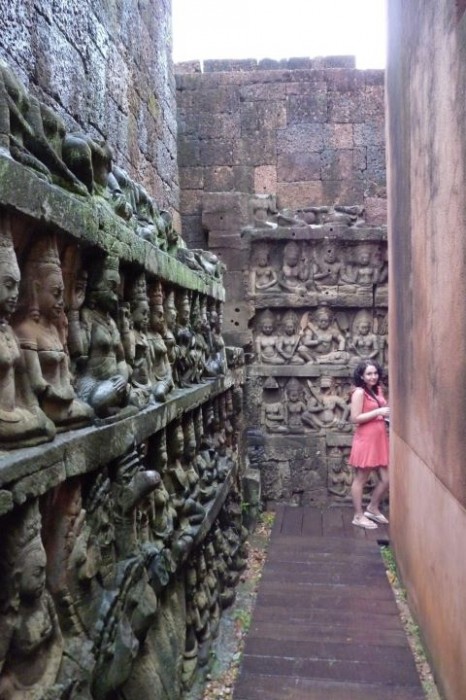 Some people seem to find it pretty strange that I’m so comfortable traveling alone. For me it was a simple equation: I wanted to go places my friends didn’t want to go and I wasn’t prepared to let that stop me. I thought that I would get lonely traveling alone, but that is so far from the truth. I had to actively take a day to myself here and there, just because I was constantly meeting new people.
Some people seem to find it pretty strange that I’m so comfortable traveling alone. For me it was a simple equation: I wanted to go places my friends didn’t want to go and I wasn’t prepared to let that stop me. I thought that I would get lonely traveling alone, but that is so far from the truth. I had to actively take a day to myself here and there, just because I was constantly meeting new people.
On my first trip in South East Asia I met a great group of guys and we traveled together for near on two months. This wouldn’t have been possible if I had a rigid itinerary, so I suggest being a bit more flexible if you’re exploring on your own. Often it’s less about the places you are and more about the people you are with. It was an incredible trip and I’m so glad that I didn’t let my initial fears of traveling alone stop me from going. There are tons of benefits to traveling alone: it pushes you outside of your boundaries, it challenges you and it forces you to adapt to new situations all on your own. I firmly believe that everyone should travel solo at some stage during their life, the lessons you learn are invaluable.
Be Twice As Sensible
I have developed a personal rule which is that I wont go out for a night on the town when I’m traveling alone, unless I know the people fairly well or the city well. One night on Koh Phangan (I’m sure many travelers have stories that start out this way…) I made the mistake of drinking a few too many free buckets. I was with a small group people I’d been traveling with for a few days. When you’re traveling, time is different. The people you’re spending time with are around you constantly, sleeping, eating, everything. So a few days of friendship could feel like months of deep and meaningful conversation and lunch dates.
At point during the night I realised I was really drunk, so told my friends that I was going to to the convenience store to buy some water and to wait for me there. I came back 10 minutes later to find everyone had left. I panicked and walked the length of the beach trying to find them. It was 3am and I didn’t confidently know my way back to the accommodation. I tried to walk around the beach, waist deep in water, before realising it was a really bad idea. I tried to walk through the dark, gloomy forest towards our accommodation before I realised that was also a stupid idea. Eventually I made it home, but it was a pretty scary and stressful experience. In the morning my friends were all really apologetic, one of the other girls had gotten really sick and they were worried about her. Just be sensible, you can’t expect too much of people you’ve only just met. So, unless you have someone you can really trust to watch your back, don’t drink in an unfamiliar place. It extends further than drinking, too. It’s simple things like avoiding arriving in a new, foreign city alone at 11.00pm. You’d probably be fine, but if you’ve got all your things on you and you’re stumbling around to trying to find your hostel, you’re really just opening yourself up for potential trouble. So, just try to minimize it.
Have a Backup Plan
Unfortunately bad stuff happens, even on holiday. The possibility of having your wallet stolen is so much more daunting when you’re alone in a foreign country. You need to have some backup plans in order to protect yourself incase something does happen. I would suggest carrying at least two cards with you, one that you keep in you wallet and one that you keep somewhere else safe. Don’t take your second card out with you when you go out, keep it tucked away in your room’s locker or safe. When I was in rural Indonesia the town I was staying in only had one ATM and my card just didn’t work. I had enough cash to carry me through my stay, but when an unexpected medical expense came up I had to pay for a driver to take me to the nearest town, over an hour away, in order to withdraw cash. If I had another card this might not have been an issue. I had similar problems with my eftpos card not working in Calcutta’s airport, but thankfully had some reserved USD that I could change into local currency. Before you even leave for your trip, make sure you make copies of your passport. I even go as far to scan them and email them to myself, so I can always access them. It’s better to be safe than sorry.
How to Meet People On The Road
It’s hard to describe this to someone who hasn’t been backpacking, but there’s this special openness in almost everyone you’ll meet. Maybe it’s because we’ve all taken the steps required to explore the world, or maybe because we’re united in the fact we’re all slightly out of our comfort zone- either way, I think it’s much easier to make friends on the road. The most important thing is to go where the type of people you want to make friends with, will be. If you want to meet other backpackers, the easiest way to meet them is to stay in a dorm! The more beds in the room, the more potential friends (though, the more potential snorers, too. But that’s an issue for another day). If you want to make friends with locals you can look to stay with someone on Couchsurfing or you can go to more local hangouts. Be approachable and approach others. There’s a standard backpackers conversation that starts off like “Where are you from, where are you going…” and while it’s sometimes painful to start it again, it’s an easy introduction. That dorm mate you spark up a conversation could wind up being your travel buddy for two months.
Be Flexible
When I think back to my favourite travel memories, most them include my favourite people I’ve met along the way. Often the company you have is more memorable than the place you’re in. Along your travels you’re likely to find some people that you just instantly click with and want to spend more time with. If your itinerary is set in stone, it restricts how much time you can spend with them. If your itinerary isn’t so rigid and they invite you along to join in for more of their trip, you’ll be able to say yes. There’s nothing worse than a jam packed time sensitive itinerary getting in the way of epic adventures, so be flexible.
Vienna – City Guide

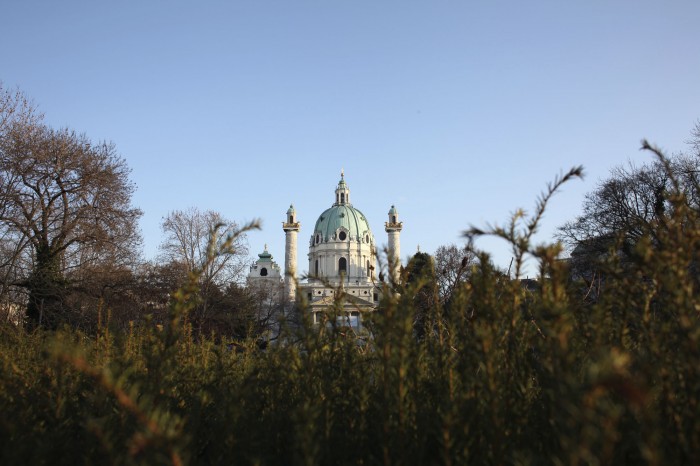
Vienna seems to mix the old with the new, effortlessly. There are enough galleries, museums and trendy cafes to please even the biggest culture seekers. Her German roots are firmly planted: the transport system is clean, fast and efficient and the old buildings are immaculately maintained. Vienna has a lovely assortment of kaffeehaus, which are traditional coffee houses. Locals are very fashionable and love to shop, so if you’re looking to get rid of a few euros, Vienna will serve you well.
Costs in Vienna
Accommodation in Vienna isn’t particularly cheap especially when compared to some neighbouring countries, however you should find a high standard across the board. For hostels in Vienna expect to pay €10 to €25 per night for a dorm. If you are looking for a private room, expect to pay from €40 upwards for the room (split that for two people). For a budget hotel you can expect a room in the range of €70 and up.
Food in Vienna is not particularly expensive. Expect to pay around €10-20 for a meal at a decent restaurant. If you shop well it would be possible to get by on €25-35 per week on groceries. For a cheap meal, find a Kebap, traditional Würstlstand (sausage) or an Austrian sandwich (available at supermarkets, for around €1). Vienna has an assortment of some of the most delicious pastries I’ve seen around the world. They make a delicious and easy breakfast or snack. Bare in mind, many places will charge you just to sit down. Tap water is great in Vienna, so save yourself some cash and refill a bottle.
Transport within Vienna is fantastic – it is one of the best systems I’ve ever used. There is an integrated transport system, meaning that the same ticket will work on the underground, trams and buses. It is affordable, frequent and clean. It is €0.40 cheaper to buy the ticket in advance, compared to on the bus or tram. If you intend on using public transport more than three times daily, consider investing in a multi pass. An individual ticket will cost € 1.80 when purchase in advance, whereas you can buy a 24 hour pass for €5.70 (48 and 72 hour passes run at €10 and €13.60 respectively). Take tram number 2 for a scenic trip around the centre of Vienna, it’s a great way to get your bearings fast.
Things to Do in Vienna
Tiergarten is the oldest zoo in the world, and also one of the most wonderful. There’s a gorgeous pavilion in the centre which is a lovely place to enjoy a refreshment during your visit. The zoo houses a wide variety of animals and in 2003 became home to Giant Pandas. At €14 (€6 for children and seniors) it’s not the cheapest thing to do in Vienna, but you can stretch it out to a full days entertainment.
Schloss Schönbrunn Gardens are very grand and not far from Vienna’s center. Walking around the perfectly maintained grounds you feel as if you could be in the middle of the countryside. While the gardens are still beautiful during the winter, they certainly come alive during the spring and summer. If you have time, it is certainly worth the tour of the Schönbrunn Palace, it is a remarkable building that is decorated elegantly throughout. An imperial tour will set you back €10,20 but I suggest paying the additional €3 for the grand tour, it is worth it.
Museumsquartieris a melting pot of Vienna’s culture. There are numerous museums, galleries, cafes, restaurants and bars housed in the former imperial stables. During the warmer months this is the perfect place to people watch or meet new people. You can just come to enjoy the sun and relax, it has a very laid back feeling to it. You can buy combined museum passes with the Kombi pass costing €25 and allowing you entry into all of the museums except zoom and a 30% discount on any performances.
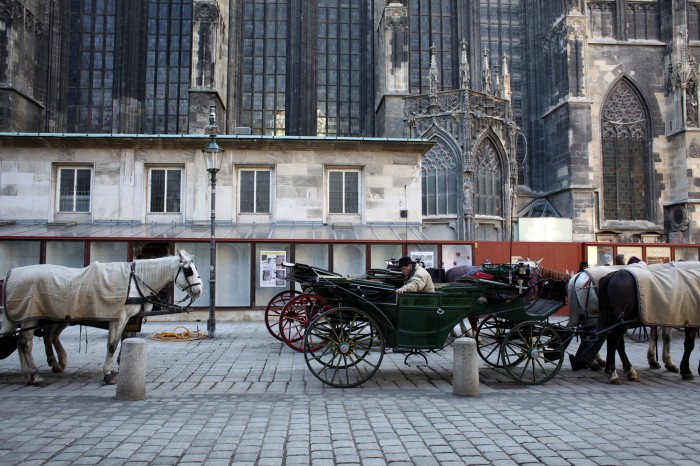
Save For Your World Trip
Unless you’re lucky enough to have a substantial trust fund or a job that facilitates travel, chances are you’re going to have to save some cash before you can get going. How much you’re going to need to save really depends on how you like to travel, but as a rough guide I would suggest $1,000USD a month for South East Asia and $2,000USD a month for South America and Europe. This will be enough to backpack around, eating out sparingly and with minimal shopping. If you’re careful with your spending, you’ll be able to sit well under budget, but those are rough estimates that are good starting points. I would advise getting in touch with people who have been to the specific countries you’re interested in visiting and ask them how much they spent daily – it’s a great way to find out how much it really costs.
How to Save Enough to Travel for a Long Time
If you’re planning to be away for a few months to a few years, I think it’s a lot easier to save up the cash that you need. This is because you’re less likely to be worried about all your possessions and more inclined to sell them. Sometimes selling things can be hard, looking through a bunch of things you’ve collected and knowing that you’re not going to get anywhere near as much as you paid for them. But, at the end of the day, it’s just stuff and they can be sold in order to provide yourself with a lifetime of memories. So, anything you can’t take with you on your trip and you don’t think is worth storing, sell. You’ll be surprised by how much bits and pieces add up to. Start listing things on EBay, Craigslist and Trademe well before you intend to leave, that way you’ll be able to settle for a good price. Store things with family and friends to cut back on costs while you are away.
Ditch Your Car
It might not be possible sell your car, but, if you can, do it as soon as possible. For many people a car is a luxury: a money gobbling insurance draining luxury. If you’re paying for insurance, maintenance, petrol and car repayments, you’re probably spending a few hundred dollars a month. That money could instead be going into your savings account, making your dream trip a little closer. It might be frustrating not having a car, but it’s only a temporary inconvenience. Opt to take public transport, or better yet by a bike and use that – that would be the ultimate way to save as much as possible on transport, while getting fit. Saving for a trip is like as a snowball: it starts out small, and it’s hard pack more snow into it, but the bigger it gets, the more snow it collects and before long it’s huge. The exact same applies with savings, the faster you plump up your account, the more motivation you’ll have to keep exceeding your saving goals.
Set Your Goals Higher Than You Can Achieve
This is the whole “reach for the moon and if you fail you’ll land in the stars” business. Chances are you can probably save more than you think. So, map out a budget and figure out how much you can save per month. Say you set your goal for $500 a month, try to put away $600 at the beginning of your pay cycle (or set aside a proportionate amount if you’re paid weekly or fortnightly). Tell yourself you’re going to try to get by without that extra hundred, but if you do need it don’t be afraid to take it out. I always employed this technique with savings and some months I found myself taking out some of the extra money to cover expenses, but for the most part I was really resistant to taking it out, even though it wasn’t my original savings goal. This little trick helped me save way more than I ever expected I could.
Coffee is Your Enemy
Well, maybe I’m being dramatic, but it is an expensive, but delicious, habit. If you’re drinking a starbucks coffee a day, that could be setting you back $5USD – which is enough to get you a private budget room in Phnom Penh for the night, or a couple of meals from a street vender in Thailand. Is that coffee really worth handing over that bill for? I really enjoy coffee and cutting it out was something that I found really hard, but it does drain your bank balance way too fast. Save coffee for a social treat with friends. It’s fine to enjoy one once and a while, but if you’re having one per day, that could be $140 a month you could be putting towards your adventures – which option is more meaningful? While we’re on the expensive, overpriced liquids conversation it’s little surprise that a night out on the town can deplete your bank balance. Try having pre drinks at home or a friends to cut down on costs, or just going out once a weekend instead of both nights. It can be a bit hard cutting down your social life a notch, but these changes will really make a difference to your savings!
Move Home or Downsize
If at all possible, take this option. I know that being independent is awesome and there’s a bit of a kick to your pride if you decide to go home but the difference this can make to your travel fund is incredible. What you’re spending monthly in rent now, could finance your accommodation for two months in South East Asia! If your parents are willing to take you, seize this option – you will be thankful when you can stretch out your travels even further. Maybe you don’t want to move home or maybe it’s just not a possibility for you. Depending on your living situation you could look at living in a cheaper place or if you’re renting alone you could consider getting a housemate/roommate to bring your costs down. So much of our incomes go towards rent, so try to cut this down as much as possible.
Make Yourself Lunch
And dinner too. Falling behind your property costs, food is probably the next biggest weekly spend. The best way to cut this down is to prepare your meals at home – whether that’s eating dinner at home or taking a packed lunch to work. I have numerous friends who eat out almost every night for dinner, not only is it very expensive, but it’s not particularly good for you either. If this sounds like you, do yourself and your bank balance a favor and start cooking at home.
Curb Your Shopping
Stop buying new clothes. Or at least cut down on buying new clothes. Those cute $300 shoes aren’t going to be that much use to you when you’re walking around Cambodia during the monsoon, feet covered in mud while you’re trying to get a good photo of Angkor Wat. You will wish you left them at home and had a pair of $3 flipflops instead. You can pick up some plain t shirts for a couple of dollars and Thailand is a shopping haven. Most of my nice clothes I took to Asia were either destroyed by the activities I was doing or the laundry services I used. I wish I’d left them at home and bought things locally to wear and donate while there. When you decide to go on a world trip, it’s probably a good idea to curb all unnecessary spending. There’s no point buying furnishings for your flat, even if you’re leaving in six months. Just be practical, if you’re not taking it with you on your trip think twice before buying it!
As cliche as it is: small changes can make a big difference. Start saving now!
Long Term Travel Is Cheap
Not everyone is interested in taking long trips away, I understand that. For some, a few weeks of the year on some tropical island is enough to satisfy their wanderlust. That’s not the case for me. In 2010 I embarked on a two week adventure to Europe (from New Zealand) where I visited Hong Kong on the way, as well as Belgium, France and the Netherlands. Four countries in two weeks, including transit. It was madness and my only real taste of travel. While I loved seeing new countries, I didn’t even brush the surface of any of them and it was expensive when you consider the daily costs.
When I finally built up the courage a few months later, quit my job and pack up everything, to explore the world. I had no idea how long my money would actually last. In fact, I was convinced that travel was SO expensive, that I thought my substantial savings would only be enough for a month or so in Thailand. I ended up traveling throughout South East Asia and on to India for 3.5 months. That trip would have gone on even longer if I hadn’t flown home for a family emergency. I was pleasantly surprised by how cheap travel in South East Asia can be, especially when you’re traveling on one-way flights.
It’s true: Long term travel is cheap and this guide will help you see why.
Maintaining life at home while you’re traveling is expensive. On my brief trip to Europe, I was still paying rent on my apartment and utilities when I wasn’t even in the country! Fortunately I was receiving holiday pay at the same time, but if you decide to take unpaid leave and have to maintain property at home it pushes the prices up a lot. Especially if you factor in additional things such as contents insurance and car insurance. You could be spending more per week on maintaining bills at home, than on your adventures!
Traveling a lot is expensive. This seems to be a contradiction, but it’s not; I’m referring to the movement you make while traveling. Most often when you’re on holiday, the transit costs can be the biggest part of the overall cost. Of course the main flights to your destination will usually be pricey, but I’m talking about the flights or transport costs within your trip. Even in Thailand, for example, a relatively cheap country to travel, an overnight VIP bus can set you back 1100 baht (USD$ 36). While this doesn’t seem expensive, if you’re taking four a week it adds up fast. You could spend two weeks in Thailand and take eight overnight buses and see lots of places… for a whole day or two each. Or, you could add a little more money to your budget (to cover accommodation, food, entertainment) and move much more slowly.
Leveraging your home currency makes all the difference. Would you judge me if I told you that I spent more in a week in Sydney than a month in Cambodia? I was staying at backpackers in both cases, but I was living a lot more comfortably in Cambodia (eating out, shopping etc). For me, traveling on New Zealand dollars, Australia was very expensive. So by traveling around South East Asia I was leveraging my currency. My flight to Asia was around 5 times the price of my flight to Sydney, so that is a cost to factor in. But the amount you pay extra in flights is quickly negated by the extra value you get for your dollar.
Having or making friends saves you money. Some parts of the world just aren’t set up for backpackers. In really cheap countries I found that, particularly in rural areas, that there aren’t really backpacker accommodation. This means you’re forced to take your own room and I usually choose an affordable guesthouse. I prefer staying at backpackers for numerous reasons and almost always will opt for a dorm instead of a private room when I’m traveling solo. Numerous times I’ve met people I’ve really liked and we’ve traveled together and split a room. This is awesome because it means your accommodation costs are instantly halved (and you have a friend, yay). You can also look into www.CouchSurfing.com to get your accommodation costs down. It’s more of a cultural/friendship exchange than using someone’s couch to save you cash. I’d suggest that you don’t Couchsurf with anyone you aren’t genuinely interested in, as that’s going against the whole purpose of Couchsurfing! I hosted a few people when I lived in New Zealand and it was awesome.
You binge less when you’re traveling long term. Well, I’m sure there are lots of exceptions to the rule, but for the most part it’s true. If you’re on holiday for a week, you’re going to want to eat out every meal you can – that’s the whole point of being on holiday, right? Whereas if you’ve been on the road for a month or two, you might find yourself feeling sick of not being able to prepare your own food. Or you might just lose the ‘value’ in eating out all the time. The same applies with drinking: it’s fun going out on a Tuesday night and getting absolutely hammered, because you’re on holiday. But eventually you tire of it and save it for more special occasions. In both cases, you wind up spending a bit less. Perhaps you grab a baguette with some spread for breakfast instead of sitting down for a $5 euro breakfast. Or maybe you’ll chill in your hostel instead of going out on a Monday night and blowing two days budget on beer.
The longer you travel, the more your priorities will shift. When you’re traveling with a finite amount of money, small changes like these can add extra days or weeks onto your trip. Try to record everything you spend in a little notebook, it keeps your spending in line. Travel doesn’t have to be expensive as you think it is, in fact long term travel is cheap – much cheaper than living at home for me.
Take Better Photos of Locals

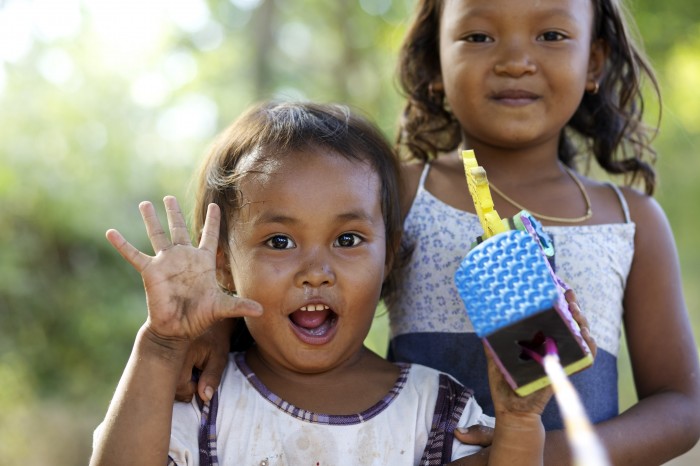
Taking photos is one of the best ways you can document your trip. While it’s great to get a bunch of photos of landmarks and your surroundings, there’s something really special about photographing the local people. This can be particularly daunting when there are cultural differences and language barriers. I’ve taken hundreds of photos with people without exchanging more than hello in the local language. Here are some tips to help you take better photos of locals:
Get Confident
Most people are flattered to have their photo taken. There will be some exceptions, but for the most part it is a compliment. In developing countries it is even a novelty too, so don’t feel bad about wanting to take their picture. If you are shy or awkward about photographing someone, that is going to influence the person you’re trying to photograph. The first few times you take photos of people you don’t know will be a little bit strange, but as you feel more confident you’ll see that your images will improve. The most important thing to remember is that the person has a right to not be in your photo and if they don’t want to, it’s fine. You’ll find someone willing soon. With this in mind, always try when you feel a photo opportunity that you’re interested in. The worst that can happen is they say no and the best is that you capture a wonderful image that you’ll treasure forever.
Smile
It’s simple really, but I think many people forget how powerful a smile is. When you’re hoping to take a photo of someone, the least you can give them is a smile. Open yourself up, be warm and friendly and your attempts to take photos will be much better received. It’s really important to make your subject feel comfortable if you want a photo where they are engaged with the camera. I have noticed that I have much higher success photographing people when I am by myself. Very few people feel comfortable with numerous cameras pointed at them, so take some time away from your friends to go off on little photo missions. I am sure you’ll be surprised with how much this little change can affect your photos.
Ask Permission
I don’t learn how to ask permission in the local language. You certainly could if you wanted to. There’s numerous reasons why I don’t bother with this, but one of them is the fact that I’m a little bit nervous before I take a photo of someone. I see people in a certain way and I put pressure on myself to try to capture them as they are. So, I think I would stumble around a foreign language and I would feel less confident than I do with my method. Even if I tried to take a photo of someone in an English speaking country, I would still employ this non verbal approach as I believe it makes things more comfortable for both sides. If I see a photo opportunity I’m interested in, usually I will hold my camera up to my eye and point it directly at the subject. This will get their attention. Then I bring the camera down to about chin height and maintain eye contact with them – usually you can judge their response by this stage. However, sometimes they need a little more prompting so I will then move my camera back up to my eye and look at their reaction through the view finder. At this point they will have either moved into a “take my picture now” pose, or will be shaking their head frantically. Respect their decision either way.

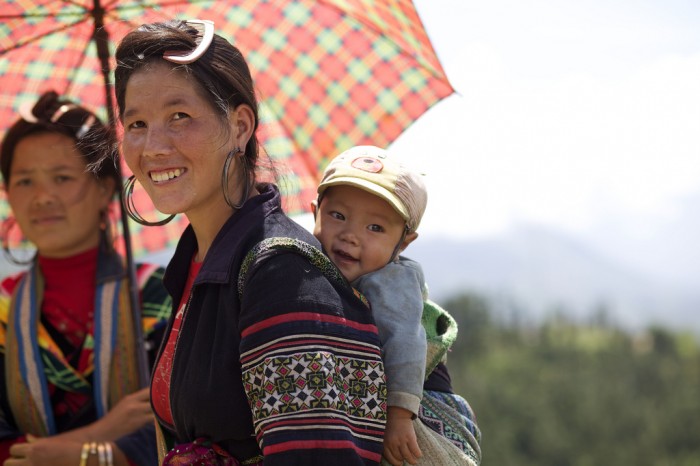
Don’t Ask Permission
I think it’s best if you can communicate with your model(s) before you take their picture, but there are always exceptions to the rule. Often asking permission will ruin the particular picture you have in mind to take. Employing the method suggested above will often yield a photograph where the subject is making eye contact with you in the photo. Sometimes that’s desirable, sometimes not. So, if you find yourself in a situation where you want a more natural photo – just take it. If it’s a crowd of people, I wouldn’t bother checking if it’s okay. But if it’s one individual person that is clearly the subject of the image, then I would be more inclined. The best way to judge whether it’s appropriate to just go ahead and shoot is to see the situation. If you’re walking the cascading rice paddy fields of Sapa and you feel compelled to take a spontaneous photo of your local guide, then chances are that is fine. Common sense will be your best gauge.
Share the Photo With Them
This can be a great way to bond with them a little more after the photos already been taken. You can simply show them any photos you took of them on your camera. If you’ve taken a photo of a child and the parents are around, walk over to them with a smile and show them. Often they will be flattered that you not only chose to take a photo, but that you wanted to share it with them too. Better yet, if you can, get some printed for them to keep too. I shoot all my photos in RAW only so it takes a few steps to get them printable. However, if you shoot in JPEG that means you can easily take your memory card to a photo store and get them printed in minutes. This can be a nice way to give back, but of course you don’t have to. When I was in Phnom Penh I saw this wonderful little girl and her father. I felt compelled to take their picture and I showed him afterwards. He was quite emotional when he looked at the photo I’d taken and asked for my email address. A few days later he wrote to me and I replied with this image. He was really grateful. This is a little way to share some of what the local people have shared with you.
These are my tips for learning to take better photos of locals. Do you love taking photos of people when you travel?
How to Volunteer Overseas
Volunteering overseas was something I always wanted to do, I just didn’t know how to volunteer overseas. I searched online and found lots of companies who were offering amazing volunteering packages in various parts of the world. But they were so expensive; some costing more than I imagined to pay on an luxurious holiday in that area. I was pretty discouraged, there was no way I could afford to spend $1000 a week for a program. Along my travels I met a girl in Laos, who had been volunteering in Cambodia. She gushed about what an amazing experience she had and when I asked her about costs I was taken back: she had spent around $7USD per DAY which included her accommodation and food. This works out at $210 a month, still well under the costs of a special program for a week. I was sold and pencilled in a month in Cambodia, with three weeks of that dedicated to volunteering at the orphanage.
My time spent in Takeo, at New Futures Organisation, was some of the best of my life. I met incredible volunteers who shared a common passion for making the world a little better, how ever they could (some of the gorgeous ladies are pictured above with me!). Our mornings were spent hiding from the hot sun, laying on the balcony having deep conversations. After lunch, we would head to the orphanage or the rural schools to teach English, help build schools, work on the drainage during the wet season, play with the kids and have our hair and makeup done (some of the male volunteers even took advantage of this)! It was the perfect balance between a social environment and really making a difference. The children were amazing and embraced the volunteers with open arms. Everyone who’s been to Takeo has this longing feeling for it! I’ve met a number of people who have volunteered in various places in Cambodia and have had similar experiences. This is a place I can personally recommend, though. Cambodia has had a rough history, with the Khymer Rouge, and it feels like a really appropriate place to give back.
How To Find Volunteer Work
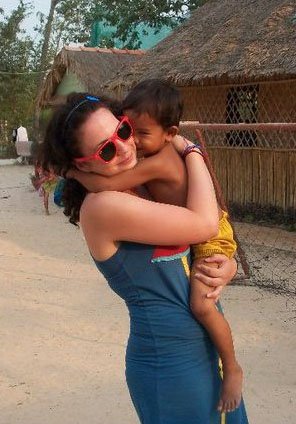 The best way to find somewhere to volunteer is through a place someone has personally recommended to you. This way you can ask as many questions as you like about it and find out what it’s really like. If you don’t know any friends who have volunteered, try using travel forums as a place to post and find out more information about the type of volunteer programs available in the countries you’re interested. Both the Couchsurfing and Lonely Planet forums have a lot of users who are happy to help. Going a step further, if you know a particular city you’re interested in volunteering in, get in touch with some Couchsurfers in that area and ask them. They’re on the ground – so to speak – and they can enquire directly on your behalf. It also means that you’re made a nice connection there, so if anything doesn’t go to plan you’ll have some people to spend some time while you’re sorting out something else. Or at the very least you’ve got someone to meet up with for a coffee, not a bad deal.
The best way to find somewhere to volunteer is through a place someone has personally recommended to you. This way you can ask as many questions as you like about it and find out what it’s really like. If you don’t know any friends who have volunteered, try using travel forums as a place to post and find out more information about the type of volunteer programs available in the countries you’re interested. Both the Couchsurfing and Lonely Planet forums have a lot of users who are happy to help. Going a step further, if you know a particular city you’re interested in volunteering in, get in touch with some Couchsurfers in that area and ask them. They’re on the ground – so to speak – and they can enquire directly on your behalf. It also means that you’re made a nice connection there, so if anything doesn’t go to plan you’ll have some people to spend some time while you’re sorting out something else. Or at the very least you’ve got someone to meet up with for a coffee, not a bad deal.
Alternatively you can try to organise something when you’re in the city, and for most developing countries in the world this shouldn’t be too hard. I spent one day volunteering having English conversations with students in a school in Luang Prabang, Laos. I could have gone along for more days, but I simply hadn’t budgeted any more time in that city. I found that suggestion in the Lonely Planet South East Asia on a Shoestring guidebook.
Another friend from Cambodia suggested the site Helpx for finding volunteer work. It’s an international site, with a variety of “projects” available, from helping on farms, in orphanages or teaching families English. You can pick a particular country you’re interested in and focus your search around that. There are a surprising number of listings and the variety is just great! If you found an organisation on there looking for volunteers that you’re interested in, you could google search them to try to see reviews that others have posted about them, or merely to find their website to get a better idea of what they’re like. It’s possible to find an affordable place, where you can really make a difference. Volunteering in Cambodia was one of the best things I ever did while traveling and it is something I hope to incorporate into my future adventures.
Being able to travel is an experience everyone should take part in. Volunteering in another country is something that can add value and meaning to your travels. Keeping track of your adventures and volunteer work through pictures is one way to hold on to the memories. Save these memories in a photo book from Lulu!
Additional resources:
Hands On Network – They provide disaster relief around the world
Volunteer South America – Lots of low cost options for South America
Free Volunteering – A resource of numerous free projects around the world
Have you ever volunteered anywhere? Tell me more about your experience!

